
We would like to welcome Jennifer Graham, a lifelong resident of the village, who has agreed to be another contributor and ambassador to What’s On Birstall. Jennifer began writing a column in the Birstall and Batley News in the early 1980’s. She then published her own book which is a very much prized possession around the village. Thank you Jennifer for joining us!
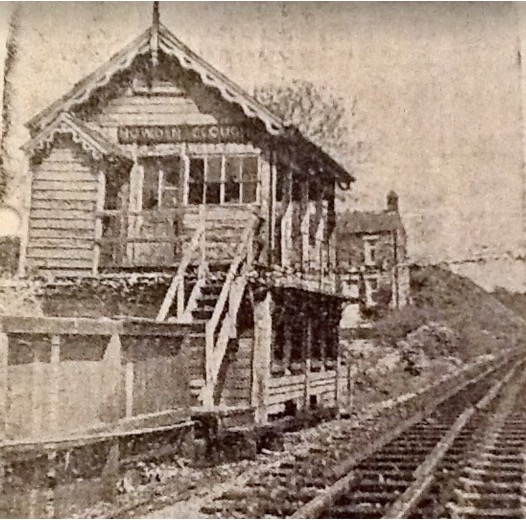

March 25th, 2024
THE HISTORIC “BUNNY RUN” – HOWDEN CLOUGH, BIRSTALL
In an old diary belonging to my grandfather it is interesting to read about the changes around Howden Clough. Grandfather started the diary when he was a boy in the late 1890’s and continued it until his death in the 1960’s.
Born in a row of cottages along Upper Batley Low Lane, known as Gladstone Terrace, grandfather lived around the area all his life. The diary includes boyhood jaunts with his friends. One of these was William Mann, who lived in Mann’s Buildings, a group of terrace houses still standing on the corner of Leeds Road and Upper Batley Low Lane. These houses had been built by William Mann’s grandfather and were lived in by local workers from Howden Clough colliery and Beckers, the local woollen mill.
This area around Howden Clough was very rural in those days. Upper Batley Low Lane was little more than a country lane, and known as ‘the bunny run’, with hardly any traffic. I remember in the 1950’s the area being mostly fields, with only a few cottages along there, but now it’s surrounded by new houses. Howden Clough has certainly changed from the small hamlet it used to be, but there is still lots of open countryside nearby. Birkby Brow Wood at the bottom of Leeds Road, known to locals as Briar Wood is still a popular place for locals to explore. On some old maps the wood is called ‘Brae Wood’ and ‘Briar’ is probably a corruption of that. And the bunny run is popular with walkers.
In his diary, my grandfather wrote how he and his friends walked along the bunny run to see some baby piglets. A local pig breeder kept pigs in the fields below the windmill and seeing the newborn piglets was a delight for youngsters. The farmer also allowed families to club together to buy a pig and keep it on his land. The families would feed the pig themselves, putting vegetable peelings and food scraps into a ‘pig bin’ ready to take to the sty.
They used to look after their pig, fattening it up so they would have joints of pork to share at Christmas. But Grandfather wrote in his diary how he didn’t think he “would be able to eat Joey” as he had come to love him like a pet!
One story I do remember my Grandfather telling us was how the piglets sometimes escaped from their styes and ran amok around Upper Batley Low Lane, near the junction with Windmill Lane.
At that time Windmill Lane was nothing more than a dirt track and my grandfather laughed as he told us how he chased the pigs with William Mann, trying to get them back into their pens. He recalled how local kids stood at the bottom of the dirt track shooing the piglets back into the fields below the old windmill and how chaotic it was!
At the bottom of what was once those open fields stands a row of terrace houses and one of them used to be a public house, called The Volunteer, the name is on a stone above the door.
As recent as the 1960’s steam trains ran through Howden Clough and people from my era still remember the excitement of seeing the ‘double header’ passing through. The old railway bridge was demolished some years ago and nowadays there is little to remind us of its location near the bottom of Windmill Lane. Train tracks have given way to a busy road now, so busy that speed humps have been installed! I wonder what old ‘Cloughers’ would think about that!
How times change but Upper Batley Low Lane is still known to locals as the “bunny run”; even though traffic races along and the pigsties have given way to new development, it is still one of the more rural areas in Birstall.
Credit: Jennifer Graham


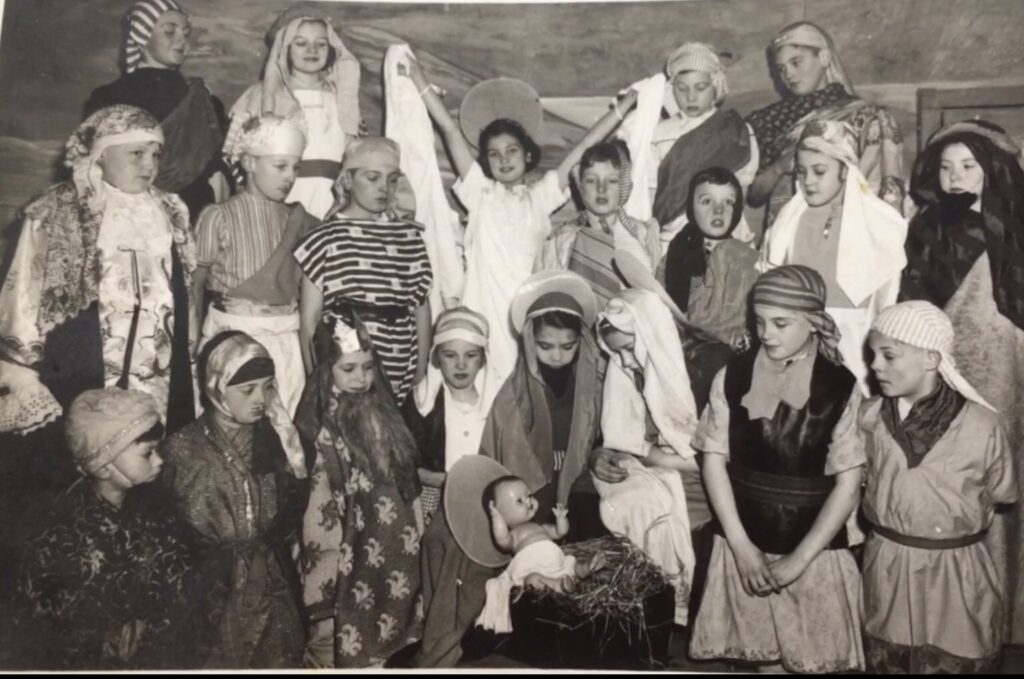
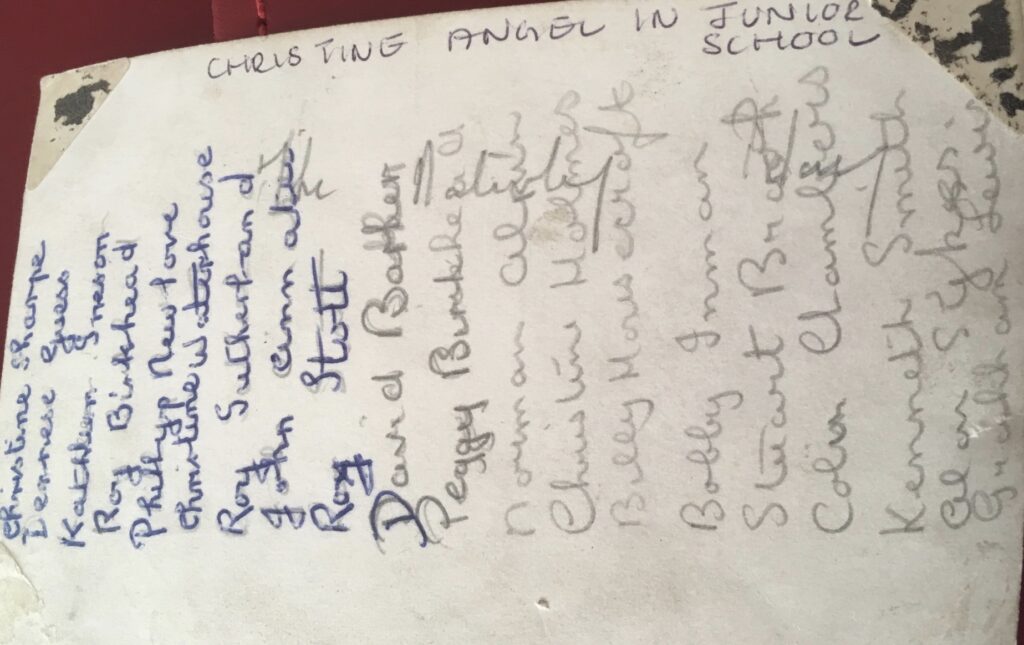
December 7th, 2023
BIRSTALL – LIVE IN THE VILLAGE OF LIGHT
How festive Birstall looks with the Christmas lights, which, apart from the Christmas tree donated by IKEA, the display is all thanks to fundraising and the hard work by a group of traders and local volunteers to set the scene. Please show your support by shopping locally!
I have found this poem from the 1930’s, which extols the virtues of shopping in the village at Christmastime and was published by the Birstall Chamber of Trade in a handbook they distributed around the area, promoting the local traders:
In price, in style, in quality remember Birstall leads,
And here you can find enough to supply all your needs.
You needn’t go to nearby towns, your Xmas presents to buy,
Or take a bus to Leeds for your Turkey, pork or pie.
So stay at home and the Birstall traders will never let you down.
Of course since this was written the shops in Birstall have changed, but shopping locally and supporting our local traders is still very important and we now have a variety of shops, plus the weekly market, to cater for our needs.
Older residents may remember these shops which supplied everything needed for the festive season. Nuttall’s in Coach Lane, Howden Clough, advertised Special Pale Ale at seven pence a pint and Burton’s on Brookroyd Lane were selling their speciality boiled hams and home made potted meats. And in Smithies Lane was Creightons who sold roasted, ground coffee, China, Ceylon and Indian teas as well as Irish and Wiltshire bacon and hams. Even writing this brings back memories of the distinctive smells in those kind of shops.
Greengrocers in the village had displays of seasonal produce. Neatly arranged tables, covered with artificial grass, held boxes of tiny tangerines, rosy red apples, and chestnuts, whilst rabbits and poultry hung limply above, amidst bunches of holly, and resting against the tables were the fir trees.
We still have a great butcher in Birstall, but years ago there were several butchers. Clifford Sheard in the Market Place, Fred Sykes on Low Lane, Glovers also in the market place (where the opticians is now). And on Huddersfield road was Henry Kitson, that shop then became Nelson Walker’s and when the premises were demolished in the 1960’s Mr Walker opened his new shop in what is now Haggarts.
Growing up in the 50’s the highlights in the run up to Christmas for us children were the school Christmas parties and the Nativity Plays. The photo here, with a list of names, shows children from St Peter’s Primary school in their Nativity Play in the late 40’s.
Another highlight for us children was a visit to Santa Claus in his grotto downstairs in the Coop Emporium. I never did find out who played this part, was it the coop delivery man, Mr Loveday? I do know that dressed as Santa Claus Mr Loveday used to drive his horse and cart through the streets, throwing penny spanishes out to us children waiting by our gates.
Magical times, never forgotten fond memories of Christmas in Birstall long ago, and now it’s thanks to the hard working groups, who are organising the Christmas lights, that today’s children will look back in years to come with their own memories of magical Birstall.
Looking forward to a happy Christmas in our wonderful community.
Credit: Jennifer Graham
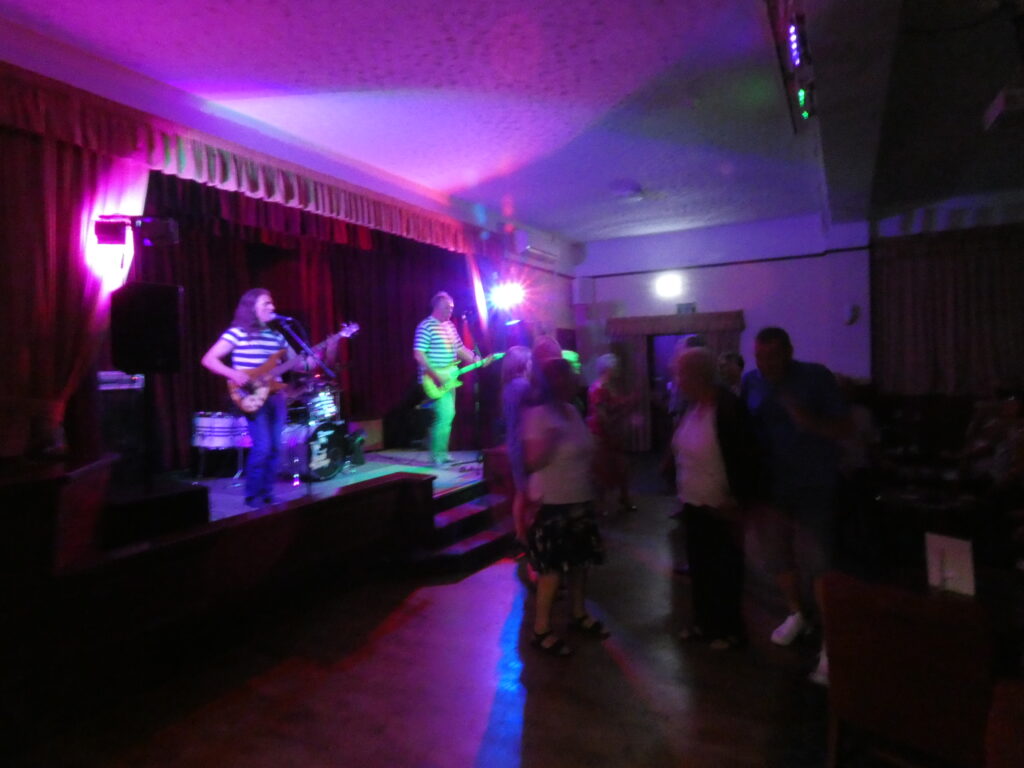
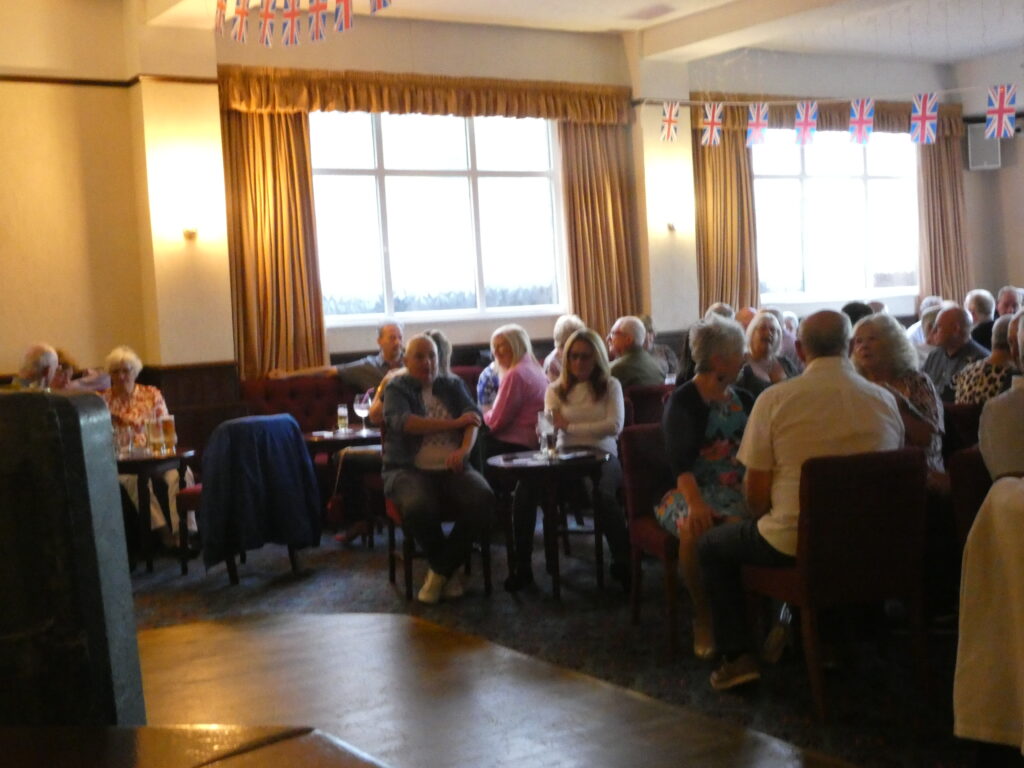
November 6th, 2023
THE IRISH CONNECTION WITH BIRSTALL – THE IRISH NASH
During the 1800’s a lot of Irish families moved to Britain during the famine in Eire in search of work, many moving into the Birstall area.
One family of six, after landing at Liverpool docks, walked all the way to Birstall to find work on a farm in Howden Clough.
Until the mid 1800’s the nearest Catholic church was in Wakefield, so every Sunday families had to walk to Wakefield and back to attend Mass. This was until 1853 when Batley got its first Priest, taking Mass at various venues until St Mary’s of the Angels was built in 1870.
Mass was not given in Birstall until 1876, in various venues until St Patrick’s was built in 1908 with its own Priest Fr Peter Russell, the youngest Priest in Britain at the time from 1905.
Popular family names at the time:- Walden, Lions, Kilkenny, Hallorhan, Lunch, Gallagher, O’Connor,Carton and Giraughtey.
In the census of 1851 most birth places were given as just Eire,but many gave just Mayo. A Lunch family of father and four daughters were described as ‘beggars’ and a Kilkenny family had ‘beggars written against three daughters,then crossed out as it was not classed as an occupation.
Most kept together in inevitable ghettos scattered around Low Lane area. By 1861 none lived East of Geldard road apart from three families over the border into Brownhill.
As the Irish were not welcomed in many taverns, they had nowhere to meet until 1885 when the first meeting place was recorded at ‘the Royal’-Market Tavern at No 4 Nelson Street, where a branch of LLTI- Land League for the Town’s Irish was formed.
This later changed in 1898 to the INL-Irish National League – Dan O’Connell branch and moved premises to the High Street (not the present day location), until 1901 when moving to Cross Street (Chandler Close) and changed to its present day name of IDL-Irish Democratic League – Dan O’Connell club,where it stayed until 1906, moving into No 5 Thorn Street (Low Lane) with rooms upstairs and downstairs converted to fit billiard tables.
Whilst here a candidate was put forward from the club for the Urban District Council elections -Dan Shillitoe,who just failed to be elected.
In February 1923 the club moved to the former Co-op reading rooms at No 27 High Street, before moving into its present day location at No 15 High Street in April 1923. The club still remains there today and celebrated its Centenary at No 15 in 2023.
Improvements were made in 1924 with a concert room. A new lounge and 40′ X 35′ concert room opened in 1963 at a cost of £10,000. Further alterations came in 1991 with a new games room.
A strong Irish connection still remains in Birstall today.
References/acknowledgment –
Malcolm Clegg’s books about the History of Birstall.
Malcolm and his sons were/are members of the IDL-Nash.
Credit: Jennifer Graham & Eddie Reynard
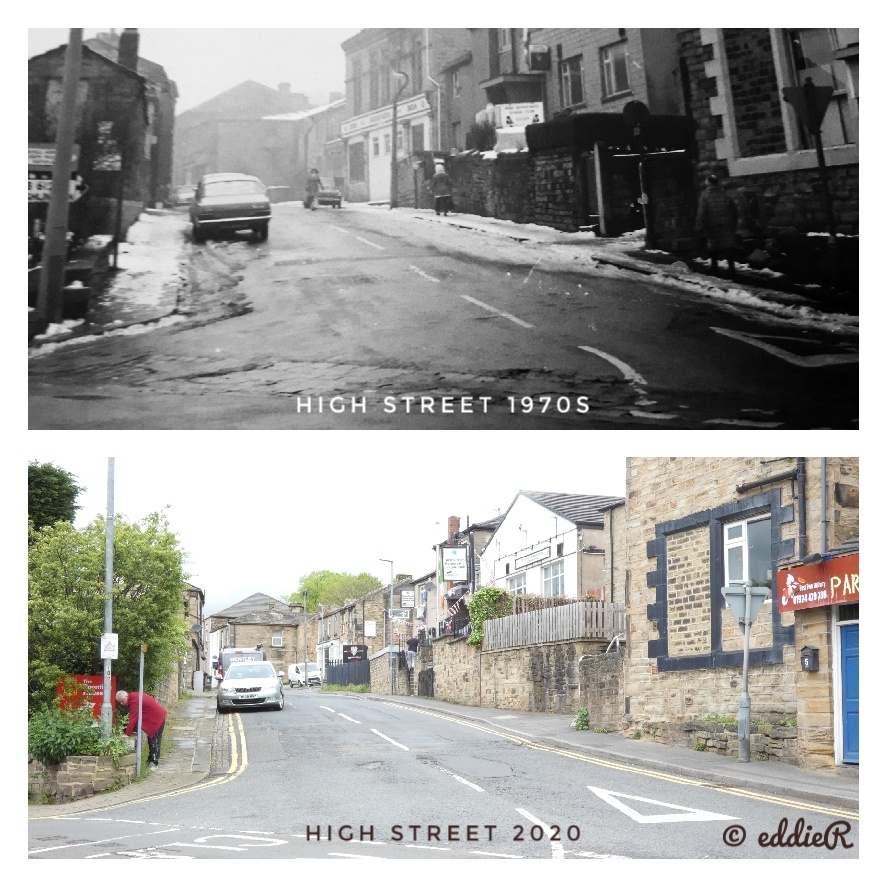
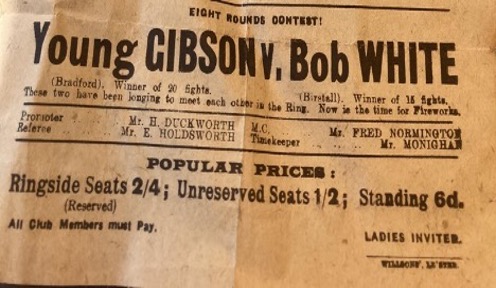
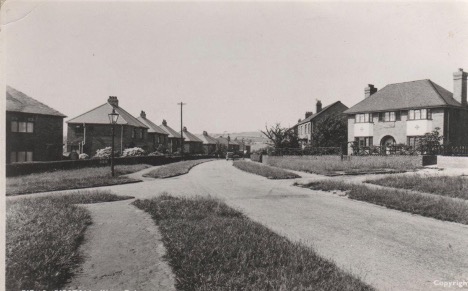
October 21, 2023
BATLEY SPORTS CENTRE
With Kirklees proposing the closure of Batley Sports Centre I was reminded of a brochure someone loaned me many years ago when Birstall had other sports facilities, in the 1930’s.
“Come to Birstall to see the Greatest Events in Boxing’ was one advert in the brochure. It went on to advertise a Great 8 round contest featuring Bob White of Birstall v Young Gibson of Bradford. At some of these contests they advertised ‘Special rates of 3d for schoolboys, doors open 6.30 pm, raised ring enables all patrons to see.’
The contests were organised by what was known as the Birstall Physical Culture Club. A well known local doctor, Dr Ogilvy, helped to set up the club when he and other local people became concerned about the lack of sporting facilities in the area, knowing physical exercise was important for keeping healthy.
The club had its headquarters in a hut on what was referred to in the brochure as Leyland Estate. Although I have no confirmation of the exact location of the hut but do remember someone once mentioning it was in the vicinity of Kings Drive.
Weightlifting and other displays of strength took place at the club and were a regular feature. However, the boxing tournaments were the most popular, with regular contests being held once the club membership became well established.
Schoolboys were encouraged to join the club and special rounds were often featured in boxing contests for them. Every year the Birstall schoolboys got together with boys from other areas and competed in the Schoolboys’ Boxing Championships.
Another Birstall venue used by the club was advertised as the Old Skating Rink in Smithies Moor Lane. I am still in doubt as to where this was actually located and as it’s from the 1930’s only the oldest residents of Birstall may remember.
The prices at the rink were slightly more expensive than the club’s headquarters. A charge of 1/6d was made for ring side seats and other seats were 1/2d including tax. Ladies were invited to attend for the special fee of 2/- for any seat, or 6d if standing.
Once the club was well established Dr Ogilvy still gave his support and sometimes even acted as referee. I am not sure if this was the doctor who locals knew as ‘Young Ogilvy’ or whether it was his father, both were family doctors in Birstall and when the older one retired his son took over the practice, hence locals knowing him as ‘young’. They lived at the bottom of The Avenue off Bradford road and I remember they had a surgery there at one time, but also had one in the centre of Birstall.
The public consultation for the proposed closure of Batley Sports and Tennis Centre can be found below.
We urge everyone to click the link and make their voice heard during the consultation window.
If Batley Sports Centre does close, maybe the ‘Birstall Physical Culture Club’ can be revived!
Credit: Jennifer Graham
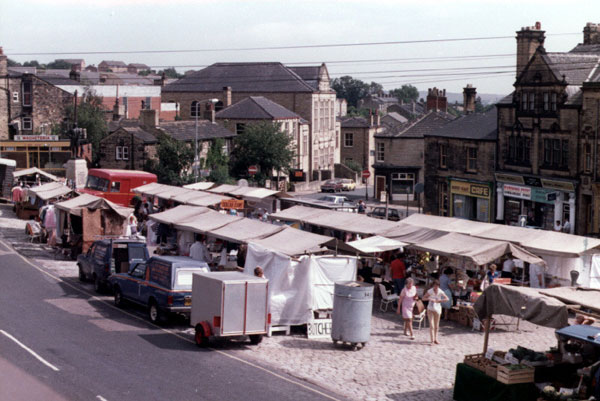
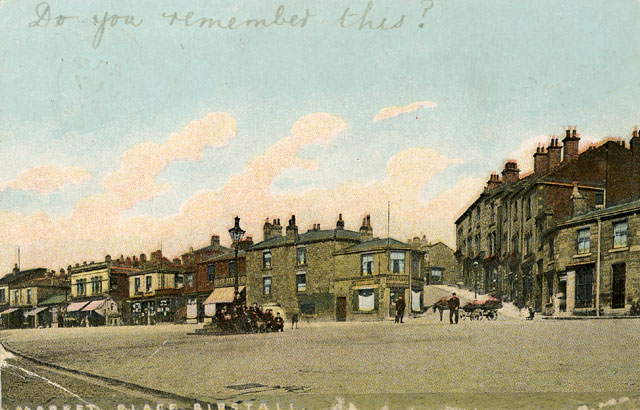
September 17, 2023
BIRSTALL MARKET
How good it is to see Birstall is now hosting not only the regular weekly Thursday market, but also a monthly Saturday market too (on the second Saturday of each month). And once again the marketplace is a thriving hub of activity.
When I first started my research into Birstall’s history in the 1970’s, I spoke to lots of older residents, all long gone now but their memories of the market are precious.
One elderly gentleman remembered how the market stayed open until late in the evening. Savvy shoppers knew that perishable food would be cheaper by then, stall holders in those days had no adequate storage facilities so they sold off leftover produce at bargain prices rather than throw it away. He described stalls loaded with pots and pans as well as the ones selling food and had a vivid memory of one stall holder who sold ointments and liniments. This was in the days when people had to pay to see a doctor and used herbal remedies. The old man recalled his mother buying ‘snake oil’ but couldn’t remember what it was used for. He remembered watching as the stallholder attracted customers by cracking a whip and calling out ‘remedies to cure all ailments’.
He also described looking under the stalls for any vegetables that had been discarded because they were partly rotten or bruised. It was good if the young boy, as he was then, found turnips, potatoes and onions as he knew his mother would use them to make a good stew.
Another old person I spoke to also recalled childhood memories of shopping in Birstall market as dusk fell, accompanying her mother looking for bargains to feed the family of seven children. Whatever the weather it was a weekly errand, being thrifty her mother looked for bargains and buying a joint of meat for less than a shilling was a real treat as it meant they could have a roast dinner on Sunday. The left over meat would be served cold on Monday, with a plate of chips, or ‘collops’ as it was washday and easy to make.
‘Collops’, or ‘scallops’ as some call them, were slices of potato dipped in batter and deep fried. The lady I spoke to said they sometimes had a meal of just collops, with salt and vinegar, it was a cheap but filling meal for them.
Every person I spoke to had fond memories of shopping in the market, and they all recalled how they looked forward to their treat. This was a visit to the ‘spice’ stall where they could choose a few sweets from the glass jars on display. That was their reward for helping their mother carry home the heavy shopping. And in autumn, when pomegranates appeared on the fruit stalls, instead of sweets these children sometimes had one of those. The pomegranate was cut into pieces and shared between the children, who took great care to remove each seed without any of the bitter skin attached.
Before the marketplace was revamped a few years ago and the old cobbles removed, the market stalls used to be secured onto metal rings set into the cobbles. I am sure many people will remember these, rusted with age some had broken but a reminder of markets from long ago. Now with a resurfaced market place it’s much easier underfoot, and, although I can’t help thinking some of the old character has been lost, it is wonderful that we once again have a thriving Birstall market!
Credit: Jennifer Graham
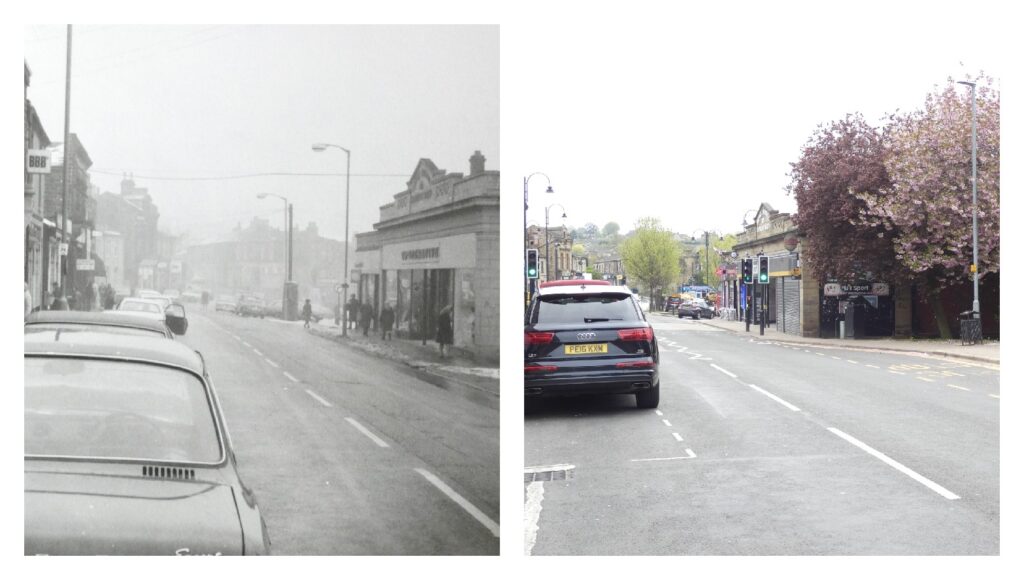
Aug 26th 2023
BIRSTALL FOOD AND DRINK
The cricket fields were well patronised and there were several good matches.Two trips were run on the Friday – one to Southport by the London and North Western Railway Company, got up by the Methodist Free Church and Primitive Methodists, and one to Scarboro’ by the Great Northern Company for the Howden Clough Reading Room Committee.
On Saturday and Sunday visitors came in thousands and the public houses and beershops were crowded to the extreme…
The two weeks prior to Birstall feast saw grocers, butchers and publicans stocking up their establishments and reported doing a roaring trade.
Bohemians commenced to arrive in good time, all for one purpose – money making. Stalls and booths were opened to the public and in a short time the town was thronged. A quack doctor of ‘astounding volubility’ advertised as a universal medicine prescriber who could cure any complaint.
The feastground was busy with merry-go-rounds, numerous side shows, marionettes, a temple of magic, shooting galleries and swinging boats. Although Birstall Feast was an annual weekend event, it wasn’t until the 1930’s that local mills closed down for the full week of the holiday.
At a meeting of the Birstall Chamber of Commerce and Batley Council in 1934 it was stated that since 1910 Birstall had been aiming to have a shut down of the local industries for feast week. And it was decided that from 1935 it would become a uniform holiday for local mills, in line with Batley. Birstall Feast traditionally began on the Saturday after the Wednesday which fell on or after 17th August each year. The actual feastground was known as “Swan Fields”.
Within living memory, many have fond recollections of Birstall Feast; it meant several things to local people – to children it was the arrival of the fairground, to the mill workers it was their annual holiday and to shopkeepers it meant closing for a long weekend.
Over the years the arrival of the funfair was eagerly awaited, twice a year. It was never called the “fair”, was always the “feast” – the Spring Feast and the Summer Feast.
Showpeople began to arrive the week preceding and their caravans and trucks slowly drifted into the feastground, once a patch of wasteland which is now an extension of Carr Street, leading through into Blackburn Road.
As the menfolk erected the stalls and rides, the women could often be seen going from house to house selling wooden clothes pegs, lucky white heather or paper flowers and maybe telling fortunes.
By Friday evening a visit to the feast was where the holiday began. The music was so loud it could be heard all over Birstall; as darkness fell the village centre was lit up like fairyland with the colourful lights from the feastground.
As you look to the right of the Coop supermarket, a few yards past the bus stop, there was a flight of steps leading from Low Lane into the feast ground. Another way was to walk past where the library is now and enter the feastground from there.
What a sight greeted people as they stepped onto what was really just an area of dusty, grimy soil. The area had been transformed! There were rifle ranges, dart games, coconut shies where parents could win a coconut or an ornament made from chalk, or cuddly toy for their children. Or the children could try winning a goldfish by hooking one of the plastic ducks sailing around a channel of water.
Prizes of goldfish were placed in a glass jam jar to be carefully carried home, held with a string handle (or, as the years went by, a plastic bag was used in place of the jar). Round glass goldfish bowls, in varying sizes, could also be bought as a more permanent home for the goldfish. Early evening was for the young children to enjoy rides on the small roundabouts, or maybe the swingboats. The swingboats were always at the bottom end of the feastground, overlooking what used to be the day nursery.
Going to the feast was an outing for all the family to enjoy, mums, dads, brothers and sisters perhaps meeting up with relatives or friends and neighbours. Mums might have their fortunes told, Dads would show their skill at shooting. All good, simple fun and a tradition carried on through generations of Birstall children.
As the evening wore on young families drifted off home and the teenagers started to arrive; flirting and trying to impress each other, all keen to take turns on the fast rides, such as the “caterpillar” or maybe on the “flying chairs”. Many a local romance began with meeting at the feast.
Girls screamed as they steered the dodgems, the boys deliberately bumping into them, sparks flying from the top of the poles. No health and safety signs in those days to deter them crashing into each other.
Thick cables snaked around the ground, making it hazardous to walk as darkness fell. The buzzing from the generators, mingled with the loud music, all added to the exciting atmosphere.
Backing onto where the library now stands, were food stalls, the last port of call for many feastgoers before going home. Candyfloss, toffee apples, brandy snap and a stall selling “chats” – tiny new potatoes deep fried and served in a cone of paper were all very tempting.
Then it was time to leave the feast, clutching a coconut or a prized goldfish. The bright lights left behind until the next visit. The feast was open on Friday, Saturday and Monday, but closed on Sunday. By Tuesday morning most of the stalls and rides had been dismantled and the caravans had started to move on to their next venue.
For the mill workers Birstall feast meant a week off work, many booked a week’s holiday at the seaside, others stayed at home or went off on day trips. The village seemed much quieter than usual with no noise from the mills and not as many people around.
Shops closed on the Monday and Tuesday of Feast week. There were no supermarkets open 24/7 so housewives had to plan their shopping and not run short of anything until the shops reopened.
Birstall feastground disappeared during the 1960’s when Batley Council started a scheme of demolishing old properties and building new ones. The land where the feast was held was earmarked for development.
The new library opened in the early sixties and new houses and flats were built and even now the area around Carr Street is still called the “feastground” by those who remember the changes.
As building commenced, for a short time the feast was held at the top of Birstall, but it wasn’t as popular and soon it ceased all together.
For those who lived through the era it was a magical time!
Click below to discover the Food and Drink options our wonderful Village of Birstall has to offer TODAY!
https://www.whatsonbirstall.co.uk/birstall-food-drink/
Credit: Jennifer Graham
September 17, 2023
BIRSTALL MARKET
How good it is to see Birstall is now hosting not only the regular weekly Thursday market, but also a monthly Saturday market too (on the second Saturday of each month). And once again the marketplace is a thriving hub of activity.
When I first started my research into Birstall’s history in the 1970’s, I spoke to lots of older residents, all long gone now but their memories of the market are precious.
One elderly gentleman remembered how the market stayed open until late in the evening. Savvy shoppers knew that perishable food would be cheaper by then, stall holders in those days had no adequate storage facilities so they sold off leftover produce at bargain prices rather than throw it away. He described stalls loaded with pots and pans as well as the ones selling food and had a vivid memory of one stall holder who sold ointments and liniments. This was in the days when people had to pay to see a doctor and used herbal remedies. The old man recalled his mother buying ‘snake oil’ but couldn’t remember what it was used for. He remembered watching as the stallholder attracted customers by cracking a whip and calling out ‘remedies to cure all ailments’.
He also described looking under the stalls for any vegetables that had been discarded because they were partly rotten or bruised. It was good if the young boy, as he was then, found turnips, potatoes and onions as he knew his mother would use them to make a good stew.
Another old person I spoke to also recalled childhood memories of shopping in Birstall market as dusk fell, accompanying her mother looking for bargains to feed the family of seven children. Whatever the weather it was a weekly errand, being thrifty her mother looked for bargains and buying a joint of meat for less than a shilling was a real treat as it meant they could have a roast dinner on Sunday. The left over meat would be served cold on Monday, with a plate of chips, or ‘collops’ as it was washday and easy to make.
‘Collops’, or ‘scallops’ as some call them, were slices of potato dipped in batter and deep fried. The lady I spoke to said they sometimes had a meal of just collops, with salt and vinegar, it was a cheap but filling meal for them.
Every person I spoke to had fond memories of shopping in the market, and they all recalled how they looked forward to their treat. This was a visit to the ‘spice’ stall where they could choose a few sweets from the glass jars on display. That was their reward for helping their mother carry home the heavy shopping. And in autumn, when pomegranates appeared on the fruit stalls, instead of sweets these children sometimes had one of those. The pomegranate was cut into pieces and shared between the children, who took great care to remove each seed without any of the bitter skin attached.
Before the marketplace was revamped a few years ago and the old cobbles removed, the market stalls used to be secured onto metal rings set into the cobbles. I am sure many people will remember these, rusted with age some had broken but a reminder of markets from long ago. Now with a resurfaced market place it’s much easier underfoot, and, although I can’t help thinking some of the old character has been lost, it is wonderful that we once again have a thriving Birstall market!
Credit: Jennifer Graham
September 17, 2023
BIRSTALL MARKET
How good it is to see Birstall is now hosting not only the regular weekly Thursday market, but also a monthly Saturday market too (on the second Saturday of each month). And once again the marketplace is a thriving hub of activity.
When I first started my research into Birstall’s history in the 1970’s, I spoke to lots of older residents, all long gone now but their memories of the market are precious.
One elderly gentleman remembered how the market stayed open until late in the evening. Savvy shoppers knew that perishable food would be cheaper by then, stall holders in those days had no adequate storage facilities so they sold off leftover produce at bargain prices rather than throw it away. He described stalls loaded with pots and pans as well as the ones selling food and had a vivid memory of one stall holder who sold ointments and liniments. This was in the days when people had to pay to see a doctor and used herbal remedies. The old man recalled his mother buying ‘snake oil’ but couldn’t remember what it was used for. He remembered watching as the stallholder attracted customers by cracking a whip and calling out ‘remedies to cure all ailments’.
He also described looking under the stalls for any vegetables that had been discarded because they were partly rotten or bruised. It was good if the young boy, as he was then, found turnips, potatoes and onions as he knew his mother would use them to make a good stew.
Another old person I spoke to also recalled childhood memories of shopping in Birstall market as dusk fell, accompanying her mother looking for bargains to feed the family of seven children. Whatever the weather it was a weekly errand, being thrifty her mother looked for bargains and buying a joint of meat for less than a shilling was a real treat as it meant they could have a roast dinner on Sunday. The left over meat would be served cold on Monday, with a plate of chips, or ‘collops’ as it was washday and easy to make.
‘Collops’, or ‘scallops’ as some call them, were slices of potato dipped in batter and deep fried. The lady I spoke to said they sometimes had a meal of just collops, with salt and vinegar, it was a cheap but filling meal for them.
Every person I spoke to had fond memories of shopping in the market, and they all recalled how they looked forward to their treat. This was a visit to the ‘spice’ stall where they could choose a few sweets from the glass jars on display. That was their reward for helping their mother carry home the heavy shopping. And in autumn, when pomegranates appeared on the fruit stalls, instead of sweets these children sometimes had one of those. The pomegranate was cut into pieces and shared between the children, who took great care to remove each seed without any of the bitter skin attached.
Before the marketplace was revamped a few years ago and the old cobbles removed, the market stalls used to be secured onto metal rings set into the cobbles. I am sure many people will remember these, rusted with age some had broken but a reminder of markets from long ago. Now with a resurfaced market place it’s much easier underfoot, and, although I can’t help thinking some of the old character has been lost, it is wonderful that we once again have a thriving Birstall market!
Credit: Jennifer Graham

Aug 26th 2023
BIRSTALL FOOD AND DRINK
The cricket fields were well patronised and there were several good matches.Two trips were run on the Friday – one to Southport by the London and North Western Railway Company, got up by the Methodist Free Church and Primitive Methodists, and one to Scarboro’ by the Great Northern Company for the Howden Clough Reading Room Committee.
On Saturday and Sunday visitors came in thousands and the public houses and beershops were crowded to the extreme…
The two weeks prior to Birstall feast saw grocers, butchers and publicans stocking up their establishments and reported doing a roaring trade.
Bohemians commenced to arrive in good time, all for one purpose – money making. Stalls and booths were opened to the public and in a short time the town was thronged. A quack doctor of ‘astounding volubility’ advertised as a universal medicine prescriber who could cure any complaint.
The feastground was busy with merry-go-rounds, numerous side shows, marionettes, a temple of magic, shooting galleries and swinging boats. Although Birstall Feast was an annual weekend event, it wasn’t until the 1930’s that local mills closed down for the full week of the holiday.
At a meeting of the Birstall Chamber of Commerce and Batley Council in 1934 it was stated that since 1910 Birstall had been aiming to have a shut down of the local industries for feast week. And it was decided that from 1935 it would become a uniform holiday for local mills, in line with Batley. Birstall Feast traditionally began on the Saturday after the Wednesday which fell on or after 17th August each year. The actual feastground was known as “Swan Fields”.
Within living memory, many have fond recollections of Birstall Feast; it meant several things to local people – to children it was the arrival of the fairground, to the mill workers it was their annual holiday and to shopkeepers it meant closing for a long weekend.
Over the years the arrival of the funfair was eagerly awaited, twice a year. It was never called the “fair”, was always the “feast” – the Spring Feast and the Summer Feast.
Showpeople began to arrive the week preceding and their caravans and trucks slowly drifted into the feastground, once a patch of wasteland which is now an extension of Carr Street, leading through into Blackburn Road.
As the menfolk erected the stalls and rides, the women could often be seen going from house to house selling wooden clothes pegs, lucky white heather or paper flowers and maybe telling fortunes.
By Friday evening a visit to the feast was where the holiday began. The music was so loud it could be heard all over Birstall; as darkness fell the village centre was lit up like fairyland with the colourful lights from the feastground.
As you look to the right of the Coop supermarket, a few yards past the bus stop, there was a flight of steps leading from Low Lane into the feast ground. Another way was to walk past where the library is now and enter the feastground from there.
What a sight greeted people as they stepped onto what was really just an area of dusty, grimy soil. The area had been transformed! There were rifle ranges, dart games, coconut shies where parents could win a coconut or an ornament made from chalk, or cuddly toy for their children. Or the children could try winning a goldfish by hooking one of the plastic ducks sailing around a channel of water.
Prizes of goldfish were placed in a glass jam jar to be carefully carried home, held with a string handle (or, as the years went by, a plastic bag was used in place of the jar). Round glass goldfish bowls, in varying sizes, could also be bought as a more permanent home for the goldfish. Early evening was for the young children to enjoy rides on the small roundabouts, or maybe the swingboats. The swingboats were always at the bottom end of the feastground, overlooking what used to be the day nursery.
Going to the feast was an outing for all the family to enjoy, mums, dads, brothers and sisters perhaps meeting up with relatives or friends and neighbours. Mums might have their fortunes told, Dads would show their skill at shooting. All good, simple fun and a tradition carried on through generations of Birstall children.
As the evening wore on young families drifted off home and the teenagers started to arrive; flirting and trying to impress each other, all keen to take turns on the fast rides, such as the “caterpillar” or maybe on the “flying chairs”. Many a local romance began with meeting at the feast.
Girls screamed as they steered the dodgems, the boys deliberately bumping into them, sparks flying from the top of the poles. No health and safety signs in those days to deter them crashing into each other.
Thick cables snaked around the ground, making it hazardous to walk as darkness fell. The buzzing from the generators, mingled with the loud music, all added to the exciting atmosphere.
Backing onto where the library now stands, were food stalls, the last port of call for many feastgoers before going home. Candyfloss, toffee apples, brandy snap and a stall selling “chats” – tiny new potatoes deep fried and served in a cone of paper were all very tempting.
Then it was time to leave the feast, clutching a coconut or a prized goldfish. The bright lights left behind until the next visit. The feast was open on Friday, Saturday and Monday, but closed on Sunday. By Tuesday morning most of the stalls and rides had been dismantled and the caravans had started to move on to their next venue.
For the mill workers Birstall feast meant a week off work, many booked a week’s holiday at the seaside, others stayed at home or went off on day trips. The village seemed much quieter than usual with no noise from the mills and not as many people around.
Shops closed on the Monday and Tuesday of Feast week. There were no supermarkets open 24/7 so housewives had to plan their shopping and not run short of anything until the shops reopened.
Birstall feastground disappeared during the 1960’s when Batley Council started a scheme of demolishing old properties and building new ones. The land where the feast was held was earmarked for development.
The new library opened in the early sixties and new houses and flats were built and even now the area around Carr Street is still called the “feastground” by those who remember the changes.
As building commenced, for a short time the feast was held at the top of Birstall, but it wasn’t as popular and soon it ceased all together.
For those who lived through the era it was a magical time!
Click below to discover the Food and Drink options our wonderful Village of Birstall has to offer TODAY!
https://www.whatsonbirstall.co.uk/birstall-food-drink/
Credit: Jennifer Graham
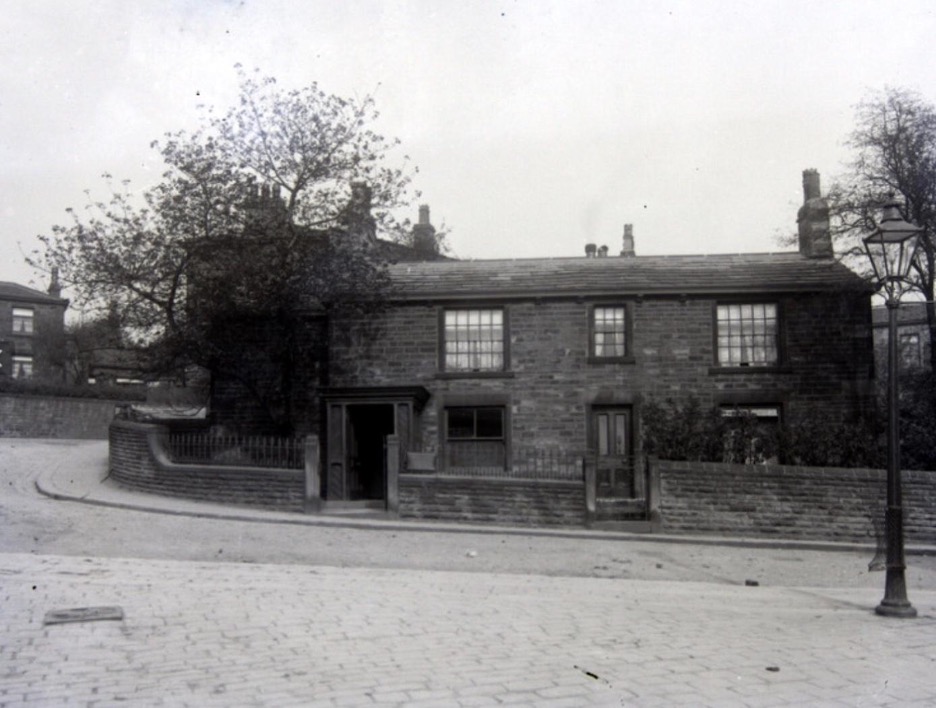
July 23rd 2023
THE OLD MIDLAND BANK
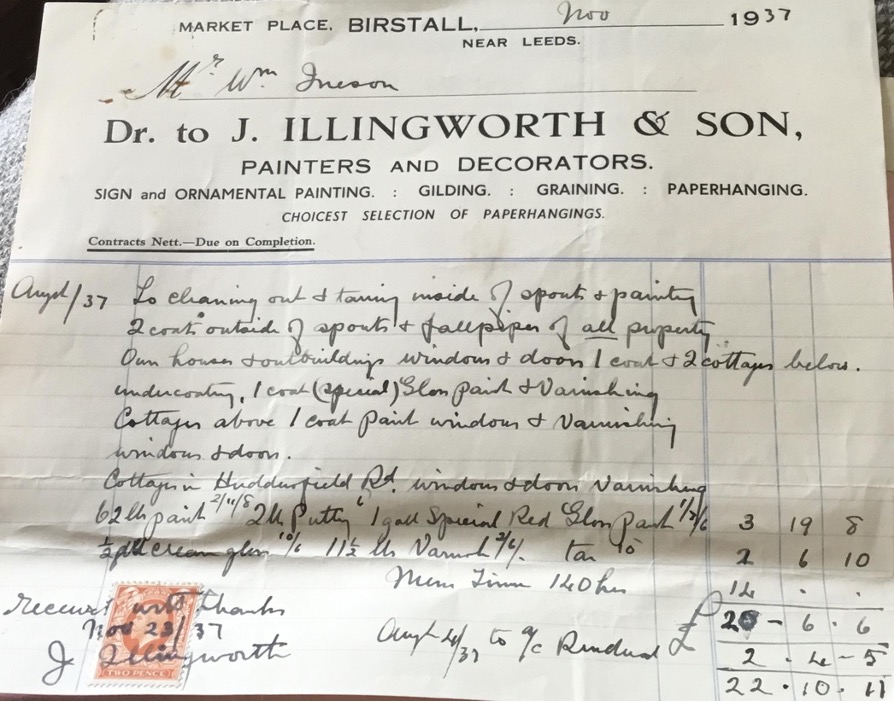
Before the Midland Bank moved across the road its new premises had previously been a painter and decorators’ shop, belonging to a well known local family, Illingworths. On the invoice pictured, dated 1937, their address was given as Market Place, Birstall and as shown they not only sold wallpaper, paint etc for people to use themselves they also had workmen who could do any kind of decorating and were a well respected family business.
I remember as a child going with my Mum to choose wallpaper, in the upstairs room of the shop were lots of rolls of wallpaper. As my Mum selected several rolls the assistant draped each one over a wooden rack to give the effect of how they would look on the wall.
Once a design was decided upon the wallpaper was taken home and then had to be ‘edged’ before it could be hung. This meant each side of the roll had to have a narrow edging strip cut off each side, using scissors, a task which was shared by all the family as it was tedious and time consuming to do! But as children we thought it was fun to have the strips to use as streamers! The Illingworth family were well known in the area, the father and brothers owned the shop and one of the sisters, Olive Illingworth, was a teacher at what was then known as the Wesleyans, later Birstall County school. Miss Illingworth had a bungalow built in Nova Lane and lived there until she retired to the coast in the 50’s. Looking at this invoice it’s interesting to see the costs of materials but also ‘men’s’ time’ for Labour was £14 for 140 hours! And notice the stamp, signed across as used to happen as proof of payment.
Credit: Jennifer Graham
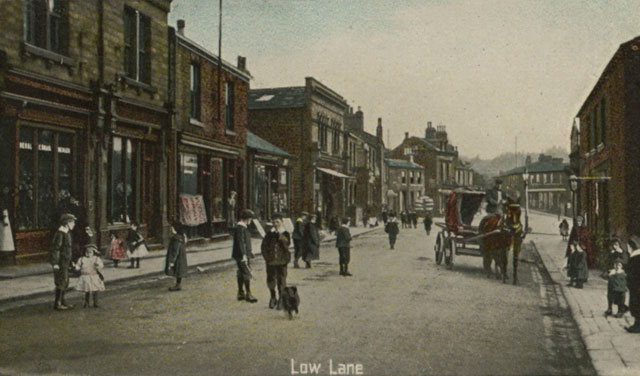
June 18th 2023
SHOPPING AND T’CO-OP EMPORIUM
“Birstall isn’t the same as it used to be.” Many people have been heard to mutter this and how true it is, take the shopping center for example. Whoever would have thought, the 1950’s when queuing for a bag of chips in the fish shop near the Dairy on Low Lane, that one day it would be possible to buy elegant clothes from the same premises, when a few years later it was turned into a Boutique, and later a Travel Agents, or that the pork butchers and dairy would become a pizza takeaway.
I imagine the shop that has changed the most is what is now the Co-op supermarket. These premises used to be known affectionately as “t’ Emporium” and what a grand place it was. There was none of today’s plate-glass frontage. Instead, a grand showcase window graced the centre of the arcade-like entrance. One could walk round the arcade and browse before actually entering the shop – so much nicer than having to stand on the pavement and gaze in the windows.
Inside the Emporium seemed to change very little over the years – the glass doomed roof hovering above the centre of the store and the old-fashioned wooden partitions dividing the various sections of each department. They sold lots of things in the Emporium – from a reel of cotton in the Haberdashery section to new furniture downstairs in the large Showroom. There was a Footwear department and in winter time this was littered with Wellington boots and their distinctive smell wafted throughout. In the Fashion department, clothes were available for every age and every occasion.
One local resident actually purchased her bridal gown and veil there in the 1930’s – all for the princely sum of one pound! The bridal gown had been given pride of place in the central display window of the arcade and the young girl decided it was the dress of her dreams.
There have been so many changes, that the Co-op is probably only one of the few still retaining their original name. Not only has the Co-op Emporium changed, the premises where the Co-op Chemist used to be was once used as a Betting Shop and the old Co-op Bread shop is now an Insurance and Estate Agency.
I doubt if many of Birstall’s newer residents will remember when the Midland Bank used to be in what is now a house (known to locals as “The Bank House”) at the top of Chapel St. The Midland moved into premises across the road and these were previously a Wallpaper shop owned by a family called Illingworth, but the same premises now also have been turned into an Estate Agency.
Credit: Jennifer Graham.

July 23rd 2023
As a teaser of Jennifer’s future contributions to the Birstall History Blog here is a great photograph. It shows Bradford Road between Brookroyd Lane and the Smithies. It shows the old railway line and St Saviours Church (Brownhill) can also be seen in the top to the right. The photo also includes Brookroyd House. Thanks again Jennifer and we are very much looking forward to sharing the fascinating content you gathered over a wonderful writing journey
Credit: Jennifer Graham.

June 11th 2023
As a teaser of Jennifer’s future contributions to the Birstall History Blog here is a great photograph. It shows Bradford Road between Brookroyd Lane and the Smithies. It shows the old railway line and St Saviours Church (Brownhill) can also be seen in the top to the right. The photo also includes Brookroyd House. Thanks again Jennifer and we are very much looking forward to sharing the fascinating content you gathered over a wonderful writing journey
Credit: Jennifer Graham.

May 23rd 2023
This photograph was probably taken at the Birstall cricket field around 1900 on Leeds Road.
E. Dickinson, who was a local greengrocer, is seated at front centre.
Credit: Birstall Community Trustees.

May 14th 2023
One of the exciting features of “What’s On Birstall” will be a “Historic” section tracking the development of our Village over the years. We will have many well known local contributors adding content to this area of the website over the coming months.
This is a photo which was kindly given to us to get started. Much more to follow in June… and thank you again for your support!
Credit: Birstall Community Trustees.